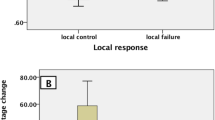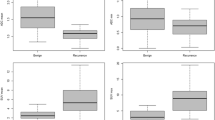Abstract
Objectives
Pretreatment identification of radio-insensitive head and neck squamous cell carcinomas (HNSCC) would affect treatment modality selection. The apparent diffusion coefficient (ADC) of a tumor could be a predictor of local recurrence. However, little is known about its prognostic value next to known factors such as clinical T-stage. The aim of the present study is to determine the added value of pretreatment ADC to clinical T-stage as a prognostic factor for local recurrence.
Methods
This retrospective cohort study included 217 patients with HNSCC treated with (chemo)radiotherapy between April 2009 and December 2015. All patients underwent diffusion-weighted MRI prior to treatment. Median ADC values of all tumors were obtained using a semi-automatic delineation method. Univariate models containing ADC and T-stage were compared with a multivariable model containing both variables.
Results
Fifty-eight patients experienced a local recurrence within 3 years. On average, the ADC value in the group of patients with a recurrence was 1.01 versus 1.00 (10−3 mm2/s) in the group without a recurrence. Univariate analysis showed no significant association between tumor ADC and local recurrence within 3 years after (chemo)radiotherapy (p = 0.09). Cox regression showed that clinical T-stage was an independent predictor of local recurrence and adding ADC to the model did not increase its performance.
Conclusion
Pretreatment ADC has no added value as a prognostic factor for local recurrence to clinical T-stage.
Key Points
• Pretreatment identification of head and neck squamous cell carcinoma patients who do not benefit from (chemo)radiotherapy could improve personalized cancer care.
• The apparent diffusion coefficient (ADC) obtained from diffusion-weighted MRI has been reported to be a prognostic factor for local recurrence.
• In this study, ADC has no added value as a prognostic factor compared with clinical T-stage.
Similar content being viewed by others
Avoid common mistakes on your manuscript.
Introduction
Patients with head and neck squamous cell carcinomas (HNSCC) could benefit from reliable pretreatment identification of radio-insensitive tumors. This would enable patient selection for primary surgery, avoiding the surgical challenges and morbidity induced by previous irradiation [1].
Several studies investigated the correlation of pretreatment apparent diffusion coefficient (ADC) and local tumor recurrence after (chemo)radiotherapy ((C)RT) [2,3,4,5,6,7]. Most studies concluded that tumors with a relatively high pretreatment ADC have a higher chance of local recurrence [2,3,4]. However, many of these studies did not account for clinical factors such as T-stage, which is known to be an important prognostic factor for local recurrence [8]. Therefore, the aim of the current study is to find the added value of ADC to clinical T-stage as a prognostic factor for local recurrence of HNSCC.
Methods and materials
An extended explanation of the methods used in this study can be found in the supplemental materials.
This retrospective study was approved by the institutional review board and the need for informed consent was waived. In total, 217 patients with HNSCC treated with (chemo) radiotherapy were analyzed in the study. Patients were treated between April 2009 and December 2015. All patients underwent diffusion-weighted MRI prior to treatment (Table S1). Available b values differed across scans with all containing at least a high (b800 or b1000 s/mm2) and a low (b0 s/mm2) b value. Median ADC values of all tumors were obtained using a semi-automatic delineation method. The outcome under investigation, local recurrence, was determined by biopsy (n = 40), by progression of a suspected recurrence (n = 11) or by death of the patient during recurrence workup (n = 7). All other patients were considered to have local control. Patients were followed up for 3 years. To determine the added value of ADC to clinical T-stage as a prognostic factor for local recurrence, univariable models containing ADC and T-stage were compared with a multivariable model containing both variables.
Results
Patients
A diagram showing the flow of patients is provided in the supplemental material (Fig. S1).
Of the 217 analyzed patients (Table 1), 14 patients (6.5%) were lost to follow-up within 3 years. Fifty-eight patients (27%) developed a local recurrence within 3 years. See S2 for an example of the DW-MRI of one of the patients.
Predictive value of ADC and T-stage for local control
No significant difference in tumor ADC between the groups with local recurrence and those with local control was found 3 years after (C)RT: The mean of median ADC values ± SD was 1.01 ± 0.18 (× 10−3 mm2/s) in the group with local recurrence and 1.00 ± 0.24 (× 10−3 mm2/s) (p = 0.72) in the group without local recurrence (S3).
The most discriminating cutoff value of ADC was 0.90 × 10−3 mm2/s. The group of patients with an ADC value higher than this value had no significant difference in the rate of local recurrence compared with the group with ADC values lower than this value (p = 0.09) (S4).
The rate of local recurrence was different for each T-stage; patients with T2 or T3 tumors had a significantly lower rate of tumor recurrence than the patients with T4a or T4b tumors (p < 0.01) (S5).
Cox regression showed that T-stage was associated with local recurrence (Table S2). The accuracy of the model expressed as the AUC was 0.66 (CI95% 0.57–0.74). In the multivariable Cox regression model containing both T-stage and ADC values, ADC was not independently associated with local recurrence (Table S3). The AUC of this model was 0.66 (CI95% 0.58–0.74) while the AUC based solely on ADC was 0.53 (CI95% 0.45–0.62) (Fig. 1).
HPV and ADC
Of the 102 patients with oropharyngeal carcinoma, 18 had HPV-positive tumors and 62 were negative for HPV. The HPV status of the 22 remaining patients was unknown. HPV-positive tumors had a significantly lower ADC value compared with HPV-negative tumors, 0.81 × 10−3 mm2/s compared with 0.97 × 10−3 mm2/s (p < 0.01), respectively. No local recurrences were detected in the HPV-positive group and 18 recurrences occurred in the HPV-negative group. Removing the 18 HPV-positive patients from the total sample of 217 patients and retesting the predictive value of ADC and volume did not change the final conclusions.
Importance of findings
The findings of our study imply that measuring pretreatment ADC does not help clinicians to predict a future local recurrence when T-stage is already known. This is unfortunate as a relatively easily obtainable quantitative tumor characteristic such as pretreatment ADC would be very helpful in recurrence prediction. The change in ADC (∆ADC) between pretreatment ADC and ADC values obtained during treatment might have more prognostic value [5, 7, 9].
Discussion
In contrast to our study, an association between pretreatment ADC and local recurrence has previously been described [2,3,4]. Most of these studies included a substantially lower amount of patients in comparison with our study. Only the study reported by Lambrecht et al [4] had a comparable sample size. This study included 161 patients and performed multivariable analysis including, amongst others, tumor ADC and tumor volume. Additionally, similar to our methodology, they created two models, one with ADC included and one without ADC and compared the performance of the models. They report an AUC, used to determine the discriminatory capacity of the first model, of 0.62 (CI95% 0.56–0.70), while for the model without ADC, the AUC is 0.60 (CI95% 0.55–0.67). These results are very similar to our findings and it supports our conclusion that ADC has no added value as a prognostic factor for local recurrence to, more easily obtainable, clinical parameters. A full discussion of the results can be found in the supplemental material.
Conclusion
In this study, we found pretreatment ADC to have no added value to clinical T-stage as a prognostic factor for local recurrences of HNSCC within 3 years after (chemo)radiotherapy.
Abbreviations
- ADC:
-
Apparent diffusion coefficient
- AUC:
-
Area under the curve
- CI95%:
-
95% confidence interval
- (C)RT:
-
(Chemo)radiotherapy
- DW-MRI:
-
Diffusion-weighted MRI
- HNSCC:
-
Head and neck squamous cell carcinoma
- HPV:
-
Human papilloma virus
- ROC:
-
Receiver operating characteristic
References
Lee SC, Shores CG, Weissler MC (2008) Salvage surgery after failed primary concomitant chemoradiation. Curr Opin Otolaryngol Head Neck Surg 16:135–140. https://doi.org/10.1097/MOO.0b013e3282f495b6
Hatakenaka M, Shioyama Y, Nakamura K et al (2011) Apparent diffusion coefficient calculated with relatively high b-values correlates with local failure of head and neck squamous cell carcinoma treated with radiotherapy. AJNR Am J Neuroradiol 32:1904–1910. https://doi.org/10.3174/ajnr.A2610
Ohnishi K, Shioyama Y, Hatakenaka M et al (2011) Prediction of local failures with a combination of pretreatment tumor volume and apparent diffusion coefficient in patients treated with definitive radiotherapy for hypopharyngeal or oropharyngeal squamous cell carcinoma. J Radiat Res 52:522–530
Lambrecht M, Van Calster B, Vandecaveye V et al (2014) Integrating pretreatment diffusion weighted MRI into a multivariable prognostic model for head and neck squamous cell carcinoma. Radiother Oncol 110:429–434. https://doi.org/10.1016/j.radonc.2014.01.004
King AD, Mo FK, Yu KH et al (2010) Squamous cell carcinoma of the head and neck: diffusion-weighted MR imaging for prediction and monitoring of treatment response. Eur Radiol 20:2213–2220. https://doi.org/10.1007/s00330-010-1769-8
Chawla S, Kim S, Dougherty L et al (2013) Pretreatment diffusion-weighted and dynamic contrast-enhanced MRI for prediction of local treatment response in squamous cell carcinomas of the head and neck. AJR Am J Roentgenol 200:35–43. https://doi.org/10.2214/AJR.12.9432
King AD, Chow KK, Yu KH et al (2013) Head and neck squamous cell carcinoma: diagnostic performance of diffusion-weighted MR imaging for the prediction of treatment response. Radiology 266:531–538. https://doi.org/10.1148/radiol.12120167
Brockstein B, Haraf DJ, Rademaker AW et al (2004) Patterns of failure, prognostic factors and survival in locoregionally advanced head and neck cancer treated with concomitant chemoradiotherapy: a 9-year, 337-patient, multi-institutional experience. Ann Oncol 15:1179–1186
Vandecaveye V, Dirix P, De Keyzer F et al (2010) Predictive value of diffusion-weighted magnetic resonance imaging during chemoradiotherapy for head and neck squamous cell carcinoma. Eur Radiol 20:1703–1714. https://doi.org/10.1007/s00330-010-1734-6
Acknowledgments
We thank A.S. Borggreve for assistance with the statistical analysis.
Funding
The authors state that this work has not received any funding.
Author information
Authors and Affiliations
Corresponding author
Ethics declarations
Guarantor
The scientific guarantor of this publication is M.E.P. Philippens.
Conflict of interest
The authors of this manuscript declare no relationships with any companies, whose products or services may be related to the subject matter of the article.
Statistics and biometry
A.S. Borggreve kindly provided statistical advice for this manuscript. One of the authors has significant statistical expertise.
Informed consent
Written informed consent was waived by the Institutional Review Board.
Ethical approval
Institutional Review Board approval was obtained.
Methodology
• retrospective
• prognostic study
• performed at one institution
Additional information
Publisher’s note
Springer Nature remains neutral with regard to jurisdictional claims in published maps and institutional affiliations.
Electronic supplementary material
ESM 1
(DOCX 2744 kb)
Rights and permissions
Open Access This article is distributed under the terms of the Creative Commons Attribution 4.0 International License (http://creativecommons.org/licenses/by/4.0/), which permits unrestricted use, distribution, and reproduction in any medium, provided you give appropriate credit to the original author(s) and the source, provide a link to the Creative Commons license, and indicate if changes were made.
About this article
Cite this article
Peltenburg, B., Driessen, J.P., Vasmel, J.E. et al. Pretreatment ADC is not a prognostic factor for local recurrences in head and neck squamous cell carcinoma when clinical T-stage is known. Eur Radiol 30, 1228–1231 (2020). https://doi.org/10.1007/s00330-019-06426-y
Received:
Revised:
Accepted:
Published:
Issue Date:
DOI: https://doi.org/10.1007/s00330-019-06426-y





